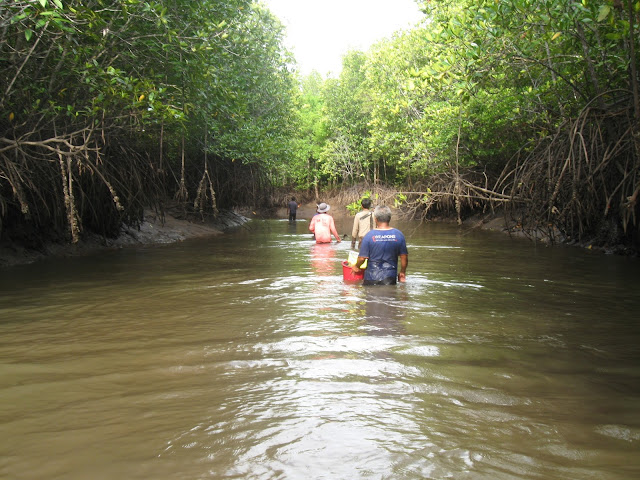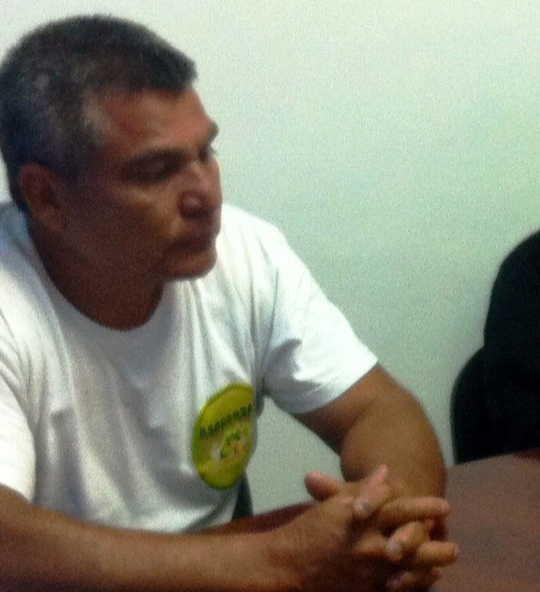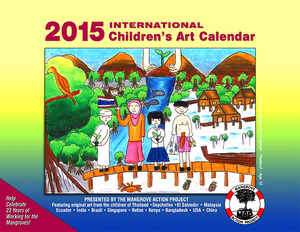|
The MAP News |
|
|
FEATURE STORY MANGROVES: OUR FOOD, OUR LIFE  GUATEMALA – The mangrove ecosystem is a unique ecosystem; fragile, the source of life and livelihood protection for people and coastal communities. Mangroves are also territory, tradition and culture. They represent only 1% of the world's forests, yet are one of the five most productive ecological units in the world. Industrial activities such as shrimp farming, oil exploration, tourism industry large-scale urban projects, construction of dams, among other projects, have led to the decline of mangroves and livelihood that sustains a critical point; threatened and endangered. Despite the destruction, the mangroves are the main source of food for communities and indigenous communities that inhabit them. Fish, shellfish and other species that inhabit this ecosystem, represent the fruits for activities such as fishing, collecting shells, crabs, and other staple food products for coastal populations. Let us pause to remember the mangrove forest of the world this July 26th! LEA MAS EN ESPANOL AFRICA Sierra Leone’s environmental agency poised to protect wetlands SIERRA LEON - Sierra Leone`s National Protection Agency (EPA) has vowed to prosecute people who make embankment on a select group of sites identified as under threat from environmental degradation. An official of the agency said Thursday the areas concerned have been declared protected by law and one of them, the Aberdeen Creek in the west end of the capital Freetown, is designated a Ramsar site. The Ramsar Convention is an international treaty for the conservation and sustainable utilization of wetlands. It came into force in Sierra Leone in April 2000, after signing it in 1996 and that binds the country to protect the area. The Aberdeen Creek is home to a vast variety of bird species and it is a major breeding ground for fish. But because of pressure on housing, people have colonized every available space in the highly overpopulated capital, including swampy areas like the creek. READ MORE ASIA Ecological Indiana Jones and the Raiders of the Lost Carbon  THAILAND - Mangroves are known to be one of the most dense carbon storage systems on earth “containing on average 1,023Mg carbon per hectare” with the soils accounting for “49-98% of carbon storage in these systems” making them at least twice as effective carbon stores when compared to other tropical forests. This high degree of carbon storage is due primarily to the tendency of water-logged soil to become anaerobic or devoid of oxygen quicker and at a higher level than most other soils. The lack of oxygen hinders microbial decomposition, thus allowing carbon rich soil to be stored for an almost indefinite amount of time especially if undisturbed. Jacob Bukoski, a graduate student at the Yale School of Forestry and Environmental Studies, is currently writing his thesis in which he describes a predictive model of mangrove carbon stocks in Southeast Asia. MAP has had the privilege of helping support Jacob’s field work because we see it as very valuable for the community and for mangrove conservation and restoration. While Jacob uses CIFOR’s “Protocols for the measurement, monitoring and reporting of structure, biomass and carbon stocks in mangrove forests” as a manual for his research, my story-telling below is a rough outline of the guide in accordance to our field work research. READ MORE Prestigious recognition for sustainable performance MYANMAR - The national Energy Globe Award Myanmar 2015 was awarded to the project “Community-based Ecological Mangrove Restoration (CBEMR)" of Mangrove Action Project. Shortly summarized the project focuses on: CBEMR is a project for mangrove restoration and reforestation in Asia, for knowledge exchange and action to reduce climate change and protect forest biodiversity with the goal of creating demonstration sites and restoring abandoned shrimp ponds. As part of this year’s World Environment Day the project was also presented by Energy Globe as part of a global online campaign (http://www.energyglobe.info) to a wide audience. The campaign ran under the patronage of UNESCO and in cooperation with UNEP and received great recognition and a large echo. “To be honored with this award is a great recognition of our work for a better environment and motivates us to continue our endeavors in the future" Alfredo Quarto, National Energy Globe Winner Myanmar READ MORE Income for Coastal Communities for Mangrove Protection  THAILAND - MAP Asia Coordinator, Jim Enright, was invited to attend a regional inception workshop for the project entitled ‘Income for Coastal Communities for Mangrove Protection’ May 7-9 in Bangkok. The objective of the project is to develop a low cost mechanism enabling investors to responsibly promote mangrove conservation, carbon emissions reduction and sustainable development through the provision of funding to local communities for livelihood diversification, resource enhancement and coastal protection. The lack of sustainable funding to support mangrove restoration is the driver for this project which has taken several years of preparation and donor hunting. The workshop brought together 38 representatives from Government, UN agencies, NGOs, the private sector and academics. Project activities will take place in Pakistan, Thailand and Viet Nam. The project is funded by the Swedish International Development Cooperation Agency (SIDA) through the International Union for Conservation of Nature (IUCN). It is implemented by the FAO Regional Office for Asia and the Pacific Office (FAO-RAP), within the framework of the Mangroves for the Future (MFF) initiative, with assistance from the USAID Lowering Emissions in Asia’s Forests (LEAF) Program and the UN-REDD Programme. READ MORE How shrimp farming wreaked havoc on Sri Lanka's coasts Sri Lanka - We are not far from the ocean here. The air smells of salt and sulphur, of marine life. But the square of black, cracked mud in front of us, bounded by its four crumbling walls of sand, is no place for living things. It was previously a pond for cultivating tiger prawns, the lucrative species that was the reason for cutting the lush mangrove forest that once covered this area. The recent history of this abandoned place is sadly representative of the story of thousands of hectares in this region in the west of Sri Lanka. A swelling appetite for shrimps and prawns in America, Europe and Japan has fuelled industrial farming of shellfish in the past few decades. The industry now has a farm-gate value of $10bn (£6.4bn) per year globally and the prawn in your sandwich is much more likely to have come from a pond than from the sea. While the industry is dominated by the likes of China, Vietnam and Thailand, a large number of other countries have invested heavily in cultivation too. READ MORE A Chemical That Killed a Countryside & Scarred a People VIETNAM – Mangroves are sturdy trees. Recognizable by their extensive root systems, these trees can thrive in muddy soil, sand, peat, even coral. They tolerate water much saltier than most other plants and survive flooding during severe storms. It is perhaps their sturdiness that led mangroves to be one of the most significant targets in the Vietnam War. During the war, communist guerilla fighters would often take refuge in Vietnam’s thick jungles. Mangroves, among other types of flora, provided shelter from eyes in the sky seeking to deliver air strikes in strategic locations. So the U.S. military exposed guerillas by bombarding the trees themselves with huge amounts of defoliants, chemical herbicides that cause the leaves to fall off of plants. The most infamous defoliant was Agent Orange, named for the orange stripes marking the drums it was shipped in. Foreign aid from the U.S. toward alleviating the effects of Agent Orange has been focused on environmental remediation rather than health care. The the need for aid to alleviate patients’ suffering is paramount and, in some ways, is more immediate than the need for research to find out how dioxins affect us. READ MORE AMERICAS Editor’s Note: We at MAP send our sincere condolences to the family and friends of Julio Lopez for their tragic loss. It is with deep regret that we learn of his murder because of his commitment to social and environmental justice. His good work for the coastal communities and the mangroves should not be forgotten. We hope that justice will be swift in arresting and prosecuting those perpetrators of this wrongdoing. Another Brave “Soldier” for Environmental Justice Murdered in Guatemala Letter from RedManglar in Guatemala:  GUATEMALA - With deep sorrow and indignation we have received the news earlier today, (Wednesday July 15) the brutal and cowardly murder of our colleague, Julio Lopez , Nueva Concepcion, Escuintla in Guatemala. Besides being vice president of the Asobordas, and chairman of the village COCODE Tecojate, Julio also was part of COGMANGLAR and Redmanglar International. Our partner was a staunch defender of the rights of communities and nature, work in several actions in defense of rivers, mangroves and against violations committed several ventures and comment against the population. In Cogmanglar, Redmanglar and Asobordas. We are deeply shocked and strongly condemn his killing, which took away a brother and fellow in our just struggles. All he wanted was the Common good and welfare of its people. Julio developed his work in one of the most violent municipalities in our country, Nueva Concepcion, now stained with blood again. Justice for our fellow soldier. Our condolences go to his family and friends. We'll always remember Julio, thanks for joining us on this path. REDMANGLAR 88 environmental advocates killed in Latin America in 2014 BRAZIL – Eighty-eight environmentalists were murdered in Latin America during 2014, according to a report by the international organization Global Witness. That amount is equivalent to three quarters of the murders of environmental activists worldwide, the report entitled "How many more?". "Every week at least two people are murdered for taking a stand against environmental destruction," says the report. "Some are shot by police during protests, others are sought by murderers. As companies seek to exploit new lands, more and more people have paid the ultimate price for their opposition, "says the report. The report also indicates that 40 percent of the victims are native peoples. Brazil leads the list with 29 activists killed, followed by Colombia with 25, 12 in Honduras, Peru 9 5 Guatemala, Paraguay 3, while in Ecuador and Costa Rica one. LEA MAS EN ESPANOL Crown Jewel of Cuba’s Coral Reefs CUBA - A marine biologist and director of Cuba’s Center for Coastal Ecosystem Research, Dr. Pina has spent much of his career studying the abundance of fish and other wildlife in this archipelago 50 miles off Cuba’s south coast, a region so fecund it has been called the Galápagos of the Caribbean. But Dr. Pina still has a long list of questions he would like to pursue. For example, he is eager to learn more about the biology, travel patterns and habits of sharks and Atlantic goliath grouper here, large, highly mobile predators that are important to coral reefs and a major tourist draw. And he hopes someday to understand why the reef in Jardines de la Reina is so resilient, when other reefs around the world are dying, succumbing to overfishing, pollution, coastal development and the effects of climate change. Scientists like Dr. Pina have only just begun to explore and document the wealth of aquatic life in the waters of the archipelago and the Gulf of Ana Maria to its north: how many species there are, the size of their populations, how they move from one area to another and where their spawning and nursery grounds are. READ MORE Seafood Watch reevaluates La. shrimp fishery USA - Louisiana commercial shrimping gear is getting an upgrade now that the state’s governor, Bobby Jindal, has signed a bill into law that will allow the Louisiana Department of Wildlife and Fisheries to mandate that all bottom trawls be equipped with turtle excluder devices (TEDs) moving forward. The passing of Louisiana House Bill 668 dismantles a previous 1987 state law that prevented La. Department of Wildlife and Fisheries agents from enforcing federal turtle-excluder device regulations. Endorsed by the Louisiana Shrimp Task Force, the bill will work to prevent unnecessary sea turtle deaths at the grips of shrimp trawls, which are estimated to kill 50,000 turtles annually when not supplemented with TEDs. "Today is a monumental day for our shrimp industry and will show the world that Louisiana fishermen and processors have always been concerned with the successful management of our shrimp fishery," Mark Abraham, the shrimp task force's chairman, said in a statement on 1 July. READ MORE OCEANA Teachers become students at hands-on science class AUSTRALIA - University Gladstone campus will be bursting with primary school teachers from across Queensland in August for National Science Week. The university is holding a hands-on event open to teachers and pre-service teachers, on Saturday and Sunday, August 22-23. An $18,266 grant received from the QGC will help to grow the exciting event. Coordinator and CQUniversity Research Fellow Dr Linda Pfeiffer said the Gladstone Marina campus location was a perfect hub for practical experiences for teachers. "We'll look at a number of aspects of environmental science in Gladstone - from water quality testing in our lab, to a guided industry bus tour, a Botanic Gardens visit, and a networking event with long-time wildlife educator Ranger Stacey from Totally Wild," Dr Pfeiffer said. The two-day event will also include a theatrical challenge for participants, to perform "The Mangrove Drama", and a boat trip and tour of Quoin Island's Turtle Rehabilitation Centre. READ MORE LAST WORD(S) Good afternoon, everyone! With great joy I share with you, that Mangrove Action Project and AEPA FALCON are driving in Venezuela the Children's Art Contest "Points of color in the mangroves" initiative seeks to project through the graphics, the perception of our children and adolescents on mangrove ecosystems, its importance and the need to protect as a world heritage. We thank all, the dissemination of this material, which attach to the legal rules of the competition and promotional poster. Education is really the strategy to awaken love and conscience. I take this opportunity to thank Monica Quarto MAP, for their support and endorsement, as Alfredo for always believing in AEPA Falcon Venezuela. Experience the mangrove ecosystem! MAS Best regards Henderson Jose Colina Ecological Association for Environmental Preservation State Falcón - Venezuela (0058) 0268.411.10.77 / 0414.688.72.65 AEPAFALCON Facebook: FALCON 100% ENVIRONMENTAL AEPA BACK TO TOP Not yet a subscriber? Click here to subscribe. Please cut and paste these news alerts/ action alerts on to your own lists and contacts. Help us spread the word and further generate letters of concern, as this can make a big difference in helping to halt a wrongdoing or encourage correct action.
|
Marvellous Mangroves Curriculum in Bangladesh - WATCH VIDEOAction Alerts: MANGROVE ART DEADLINE EXTENDED!
|
Mangrove Action Project
Click here to view past newsletters |
|
Search News Archive
Thursday, July 23, 2015
MAP News Issue 369, July 25, 2015
Subscribe to:
Post Comments (Atom)
-
The community of adults and youth in Cayman Islands has come together recently to release a series of educational videos. Each is geared to...
-
By Alfredo Quarto, Program & Policy Director Co-founder, MAP There is a rather urgent situation concerning the bio-invasion of the Son...
-
By: Isabel Robinson, MAP Volunteer Intern Some months ago I decided to come to Thailand and do an internship in mangrove conservation, ...
MAP News Issue #595 - April 6, 2024
Push to restore Philippines' mangroves at risk from salt farm law PHILIPPINES - Along the flood-prone coasts of the Philippines, one o...









No comments:
Post a Comment
Note: Only a member of this blog may post a comment.